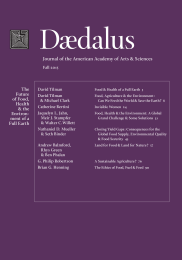A Sustainable Agriculture?
The defining challenge of sustainable agriculture is the production of food and other agricultural products at an environmental cost that does not jeopardize the food security and general welfare of future generations. Feeding another three billion people in the face of climate change, biodiversity loss, and an environment already saturated with excess nitrogen and other reactive pollutants requires new approaches and new tools in the design and deployment of workable solutions. Solutions will be local but all will require an ecological systems approach that considers sustainable farming practices in the full context of ecosystems and landscapes. And their deployment will require an understanding of the social systems capable of building incentives that produce socially desired outcomes. Socioecological models for agriculture provide an opportunity to explore feedbacks, trade-offs, and synergies that can optimize and strengthen emerging connections between farming and society. With the right incentives, innovative research, and political will, a sustainable agriculture is within our reach.
For the past twenty-five years, agricultural stakeholders ranging from “Big Ag” to public nonprofits have asserted the need for a more sustainable agriculture. Over the same period, agricultural production has intensified. In the developed world, we now produce more food, fiber, and fuel than ever before, on a land base that is either largely stable or shrinking. There are myriad problems associated with agriculture as it is currently practiced. Calls for a reformed, sustainable approach are welcome and have accelerated.
What, exactly, is sustainable agriculture? Definitions of agricultural sustainability abound, ranging from the encyclopaedic to the legislative.1 Strictly defined, sustainable agricultural systems are those capable of persevering.2 Few would argue, however, that this definition is sufficient.
A more useful definition of sustainable agriculture identifies human intent, most succinctly embodied in the legal construct of usufruct, which, back in Thomas Jefferson’s time, referred to “the right to make all the use and profit of a thing that can be made without injuring the substance of the thing itself.”3 Jefferson used the concept in his 1789 letter to James Madison: . . .
Endnotes
- 1Gale Group, Berkshire Encyclopedia of Sustainability (Great Barrington, Mass.: Berkshire Publishing Group, 2010); and United States Congress, Food, Agriculture, Conservation, and Trade Act of 1990 (FACTA), Public Law 101–624, 101st Cong., 1989–1990 (July 6, 1990).
- 2G. Philip Robertson and Richard R. Harwood, “Sustainable Agriculture,” Encyclopedia of Biodiversity, 2nd ed., ed. Simon Levin (New York: Academic Press, 2013), 111–118.
- 3Robert Chambers and Samuel Johnson, A Course of Lectures on the English Law: Delivered at the University of Oxford 1767–1773, ed. Thomas M. Curley (Madison: University of Wisconsin Press, 1986).
